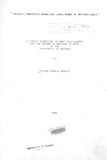| dc.description.abstract | The study aims at establishing the extent to which the women own
property. The study is based, almost entirely, on a survey carried
out in We st Bunyore Locat ion of Kakamega Districtic Western Province of Kenya.
The central thesis of this research study is that lack of property
ownership is a major constraint on women's full participation in
development in their communities.
The study presents some of the factors which facilitate ownership
of property and those which inhibit or act as constraints to
acquisition and ownership of property by women. Of special
significance to the study is the position of women with regard to
marriage, inheritance and bridewealth and how these affect the
management of resources at the farm level.
Also considered is women's access to educational facilities, and
t be extent to which these constrain women's entry into formal
employment and therefore ownership of property. In the face of a
narrowing land base and rising women in the rural areas of Kenya
have to be enabled to own property through education and
acquisition of skills. The success of agricultural improvement
measures in rural areas requires that women be educated.
At the sam e t ime, st rue t u res sue has the fin an cia 1 ins tit uti 0ns
which have discouraged or hindered women from owning property be
relaxed.
The study opens with a brief review of the problem statement
concerning property ownership. The fact that this issue has been
taken for granted and not given much recognition in relation to the
position of women is of major concern. The analysis stresses that
lack of property ownership by women is a socio-economic hindrance
to their involvement in development. This is followed by a brief
review of the literature related to the study. The literature
gives determinants of property ownership, both at the international
and national levels. A historical background 'is presented,
indicating property ownership patterns in Africa during the
precolonial and post independence periods. A review of literatur~
on women in relation to the acquisition of property indicates the
constraints that influence ownership. Factors that hinder and/or
facilitate ownership of property are considered.
Simple random sampling and systematic random sampling techniques
were employed in the selection of the respondents. The individual
woman was the unit of inquiry while the households were the
respondents. The major data gathering tool used was the interview
schedule. The chi-square, co-efficient correlation and percentages
are the major tools for data analysis.
Due to limitations of time and expenses, the study focuses on
property ownership among Luhya women in Kakamega District, as a
factor affecting their participation in Development.
The study shows that the level of formal education has a
significant influence on the type of occupation and therefore a
determinant of influence on control, allocation and disposal of
property with the married women having more authority to ownership
than the single separated widowed and divorced women.
However, the bridewealth paid for a woman during her marriage did
not have a significant relationship with ownership of property.
The research findings indicate that the lack of property ownership
lowers the economic status of not only the women but the entire
family. The analysis shows that marital status and children are
important determinants of property ownership.
The study shows that the level of formal education has a
significant influence on the type of occupation and therefore a
determinant of property ownership. The findings further show that
marital status has an influence on control, allocation and disposal
or property with the married women having more authority to
ownership than the single, separated widowed and divorced women.
However, the bridewealth paid fDr a women during her marriage does
not have a significant relationship with ownership of property.
In conclusion, the study underlines the point that women are major
contributors to the agricultural development in the rural areas.
This could be witnessed in the various activities they are engaged
in. The analysis further concludes that although women playa
significant role in rural development, they are not guaranteed the
proceeds of their labour. More often than not, they remain
providers of labour and not beneficiaries. | en |

